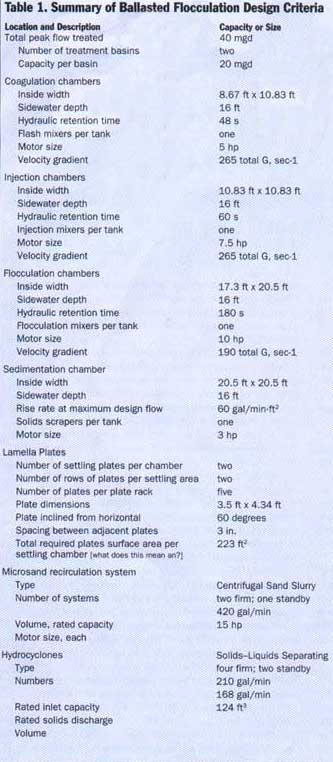|
|
|
Clarified
water then flows over effluent weirs to the excess-flow chlorine contact
basin. At this basin, the flow is disinfected by sodium hypochlorite
and dechlorinated with sodium bisulfite. It is then blended with treatment
plant effluent and discharged to the Kansas River.
.....The microsand-solids mixture collected
at the bottom of the sedimentation chamber is withdrawn and pumped
to a hydrocyclone, which separates excess water and solids from microsand.
The separated microsand is concentrated, discharged through the bottom
of the hydrocyclone, and reinjected into the ballasted flocculation
process. Most of the microsand is recycled in the ballasted flocculation
basins for further flocculation. The solids separated by the hydrocyclone
will flow by gravity back to the head of the plant to the influent
pumping station, where they are treated by the main biological treatment
process.
Mechanical
Checkout and Performance Testing
After the ballasted flocculation basins were constructed, each basin
was checked mechanically and tested for performance. The ideal time
for process performance testing is during wet weather events, but
it is difficult to predict when a storm event will occur. So, the
project team developed a plan to simulate a storm event to test
the system (see Table 2, p. 33). However, this plan proved to be
unworkable because the influent pumping was being modified.
.....Furthermore, during ballasted
flocculation basin testing, more than 50% of the primary basin capacity
was out of service due to construction, so the primary basin effectiveness
was low. Total suspended solids in the primary basin effluent were
about 140 to 180 mg/L, which is in the anticipated range of influent
flow to the ballasted flocculation basins, so primary basin effluent
was used during mechanical equipment checkout, process optimization,
and performance testing. The effluent was stored in the holding
basin for excess-flow stormwater and pumped to the splitter—screening
facility by temporarily installed pumps.
.....During testing, separated solids
were pumped to
the liquid process streams downstream of the primary basins. If
the chemically enhanced solids had been recycled during the performance
test, the project team was concerned that they would enhance the
polymer and ferric chloride dosages and skew the results.
.....After the ballasted flocculation
equipment was completely field-tested, mechanical startup testing
began. Because the ballasted flocculation basin is discharged directly
into the Kansas River and this was the first sanitary sewer overflow
facility of its kind, the project team designed two testing operations.
In the first, the facilities were operated with a blend of nonpotable
(disinfected plant effluent) and service water to alleviate any
concerns about direct discharge into the
|
